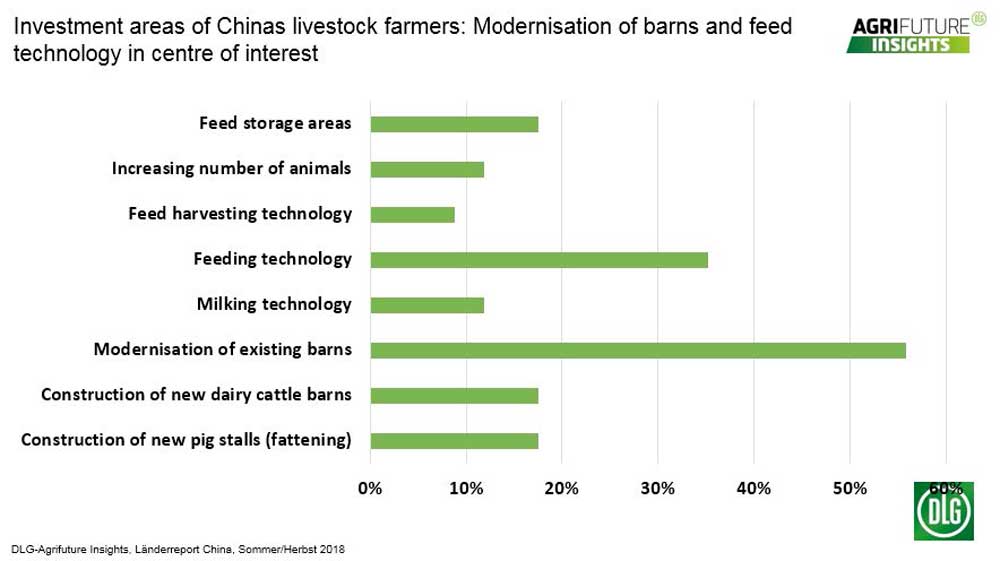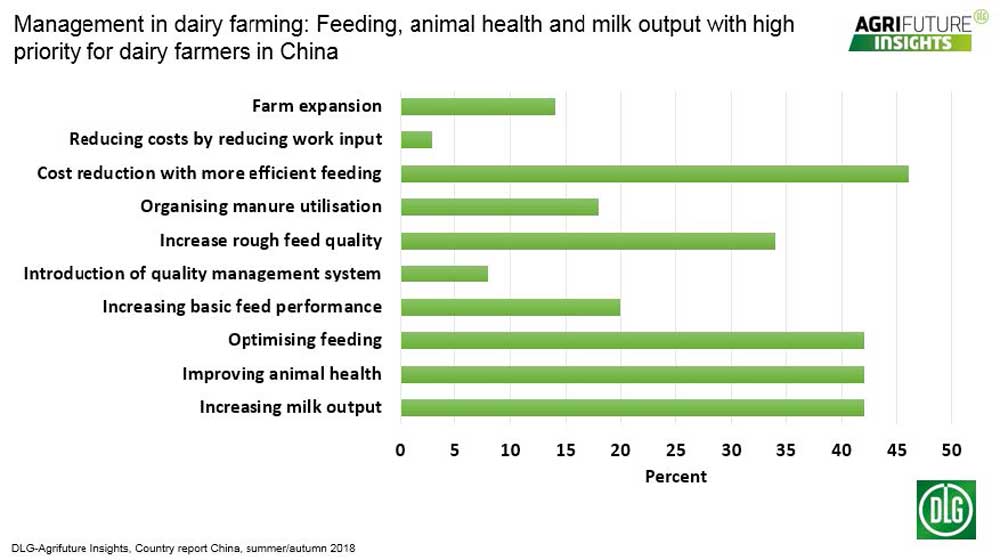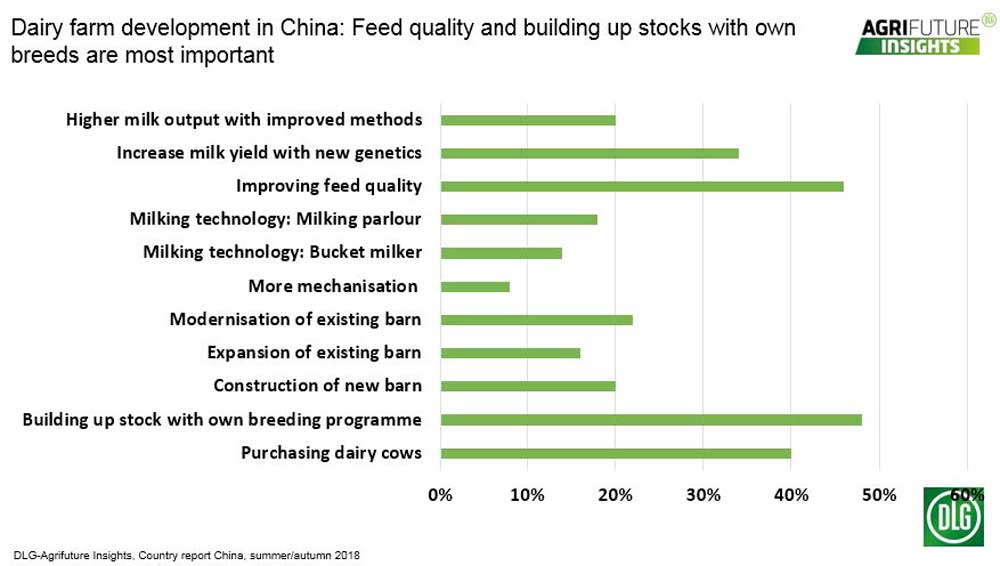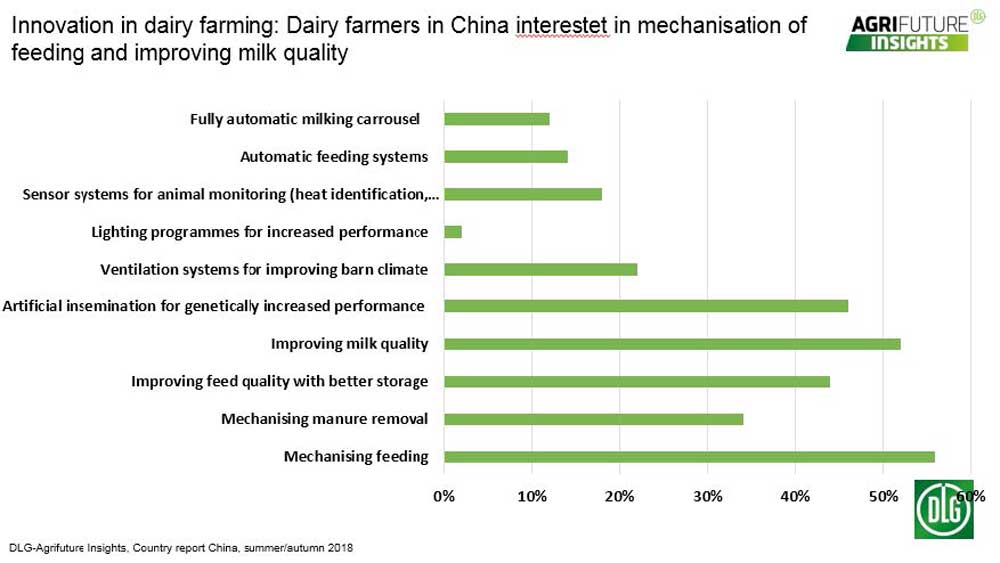Main focus of Chinese Dairy cattle farmers on genetics, building up stock and feed quality
By DLG
China's milk market is still characterised by extensive imports. Since the melanin scandal in 2008/09, Chinese milk producers have been increasing production, however this increase is not keeping pace with the growing demand. For the challenges are great: Farmland is in short supply and milk production is competing with other business segments like poultry and pig farming. This results in milk often being produced at weaker locations far away from the markets. That necessitates long transports with an uninterrupted cooling chain to regions where the demand exists. The organisation of a value-added chain that also functions optimally with regard to logistics therefore plays a key role in increasing milk production.
The modernisation of domestic milk production is especially based on the construction of large barns. The goal is to increase the raw material base for processing milk and to improve the quality of the milk produced. Another element of the modernisation strategy of the dairy industry is therefore the support of large diaries. For they modernise the sector by integrating milk producers in the value-added chain with the objective of producing quality milk and milk products for the developing retail food trade. Against this background, there is a need for modern technology and modern methods for dairy cattle farming.
Focus of investment of livestock holders in China
The modernisation of existing barns is the most important reason for investment of the farm managers surveyed in China. For the efficiency of milk production is low and the modernisation of feeding technology, cow comfort, etc. are aspects for improving production processes with the goal of increasing productivity. In addition, the focus is also on investments in feeding technology and feed storage areas. For farmland is a very scarce factor in milk production, which is why the amount of milk produced per hectare of forage area must be increased. For this reason, feeding technology and feed storage areas are important areas of investment for milk producers in China.
The construction of new dairy cattle barns is also an important investment area. The Chinese government intends to further increase the country's own production and is therefore particularly supporting the construction of large dairy cattle farms. In the course of the increase in barns, 12 percent of the farm managers surveyed intend to increase the number of animals on their farms.
Focus on milk marketing and profitability
Two-thirds of the dairy cattle farmers surveyed in China state that milk marketing is the greatest challenge. For milk production largely takes place at locations far away from the markets. Transport to the regions where there is a demand for milk in the urban areas makes uninterrupted cooling chains necessary. Cooling chains are also to be created with government support for milk processors.
On the other hand, small and medium-sized farms still market their milk fresh at local markets.
The surveyed producers see another important challenge in ensuring profitability. For even if producer prices are high in an international comparison, profitability is under pressure due to high feed costs, low milk output and low efficiency. As a result, milk producers evaluate the optimisation of feeding and animal health as other important challenges. For with more efficient feeding, feed costs can be lowered and output increased with healthy herds, therefore improving profitability.
Management fields in dairy cattle farming
When asked about the most important management fields, feeding becomes the focus. For the milk producers surveyed evaluate a cost reduction of milk production with more efficient feeding as the most important area of activity. For forage areas are in short supply and basic feed is expensive. The avoidance of feed losses, high feed consumption of animals and need-oriented feed provision are starting points for optimising feeding and reducing feed costs.
With over 40 percent of mentions, increasing the milk output, improving animal health and optimising feeding are important areas of activity of milk producers.
Improved feed and breeding are the key development factors
In addition to the current areas of activity, milk producers were also asked about their approaches for mid-term farm development. According to the assessment of the milk producers surveyed, the focus of farm development is on building up stock with own breeding programmes and increasing feed quality. New genetics is also of great interest for building up herds. For breeding is an important starting point for increasing the milk productivity of cows and at the same time for improving the health status of herds. For healthy, efficient cows are the basis for economical milk production. As a result, farm managers have an eye on better feed qualities, for with a higher performance level, the requirement for high-quality, high-energy feed increases.
Technical innovations
The question of the most important technical innovations reflects the focus of farm development. For the producers surveyed are especially interested in innovations in technology for higher milk quality and for more efficient feeding. Innovations in storage technology for basic and high-performance feed is at the focus of farm managers, for clean, dry storage is necessary for avoiding feed losses.
Altogether it is apparent that for the milk producers surveyed in China, feeding is a major area for producing milk more efficiently and less expensively. And the clear interest in milking technology for larger numbers of livestock shows the trend to modernisation and the need for innovative technology.
DLG-Agrifuture Insights
DLG-Agrifuture Insights is the new DLG knowledge brand and platform for international trend analyses in the agricultural sector. It examines the business environment in agriculture and agricultural business with a global panel of 2,000 leading farmers in 13 countries. Each month Agrifuture Insights will publish a "Graphic of the month" from the extensive range of development trends on the international agricultural markets.
Interested persons can obtain additional information on DLG-Agrifuture Insights from the DLG. The contact is Dr. Achim Schaffner, Head of the Economy Department, Tel.: 069/24788-321 or e-mail: afi@dlg.org. Information is also available at www.DLG.org/afi.







